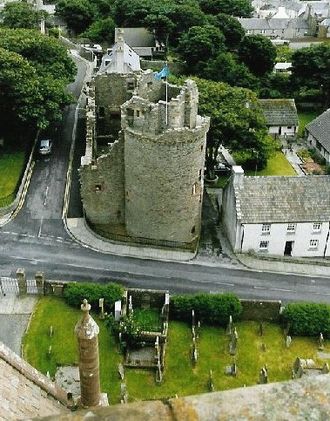Bishop's Palace, Kirkwall facts for kids
Quick facts for kids Bishop's Palace |
|
|---|---|

Bishop's Palace, seen from St Magnus Cathedral tower
|
|
| General information | |
| Status | in ruins |
| Type | palace |
| Architectural style | Romanesque, Gothic |
| Town or city | Kirkwall |
| Country | Scotland |
| Owner | Historic Environment Scotland |
The Bishop's Palace, Kirkwall is a very old building in the centre of Kirkwall, on the Orkney Islands in Scotland. It was built around the 1100s, at the same time as the famous St Magnus Cathedral next door. This palace was home to the first bishop of the cathedral, a man named William the Old. He was part of the Catholic Church in Norway and got his authority from the Archbishop in Trondheim. Today, the palace is mostly in ruins, but it still looks a bit like a small, ancient castle.
Contents
History of the Bishop's Palace
Early Days and Royal Connections
The Bishop's Palace was first built to look like a typical royal palace in Norway. It had a large hall on the upper floor, with storage rooms below. There was also a tower house which was the Bishop's private living area.
A very important event happened here in 1263. King Haakon IV of Norway stayed at the palace during the winter after the Battle of Largs. Sadly, he died there. His death marked the end of Norse rule over the Outer Hebrides and Orkney. After this, the palace was not looked after very well. By the year 1320, it had fallen into ruins.
Changes Over Time
In 1468, the Orkney and Shetland islands became connected to the Scottish crown. This happened when Christian I of Denmark and Norway promised them as payment for his daughter Margaret's dowry. She was going to marry James III of Scotland. The money was never paid, so the islands have been part of Scotland ever since.
In 1526, the palace was briefly owned by Lord Sinclair. But he was soon told to give it back to the Bishop of Orkney. When King James V of Scotland visited Kirkwall in 1540, he used the palace to house his soldiers. He also used Kirkwall Castle for his troops.
Soon after, a lot of repair work began on the palace. This was done by Bishop Robert Reid. He was the last of Orkney's bishops from the Middle Ages. Bishop Reid also started the University of Edinburgh. He added a round tower to the palace, which was called the Moosie Toor.
Later Years and Conflicts
In 1557, a fleet of ships from England came to Scotland. Some English troops attacked the cathedral on August 12th. The next day, they tried to capture the Bishop's Palace but were defeated. Many of the English soldiers, including their leader, drowned while trying to get back to their ships.
Ownership of the palace later went to Robert Stewart, 1st Earl of Orkney, in 1568. Then it passed to his son, Patrick Stewart, 2nd Earl of Orkney. Earl Patrick wanted to make the Bishop's Palace part of his own grand Earl's Palace, Kirkwall. However, he had many debts and had to give the palace back to Bishop James Law.
In 1614, Earl Patrick's son, Robert, took control of both palaces. This led to a siege, which is when an army surrounds a place to try and take it over. It's not known if this fighting caused more damage to the buildings. Both the Bishop's Palace and the Earl's Palace are now ruins.
Visiting the Palace Today
The Bishop's Palace is open for people to visit. It is looked after by Historic Environment Scotland, which is an organization that cares for important historical sites. The palace is considered a scheduled monument, meaning it's a nationally important historic place.
The palace and the nearby Earl's Palace were closed to visitors from October 2023 to March 2024. This was so that experts could check the high parts of the stone walls. This work was part of keeping the old buildings safe and preserved for the future. Now, visitors can explore these historic ruins once again.

